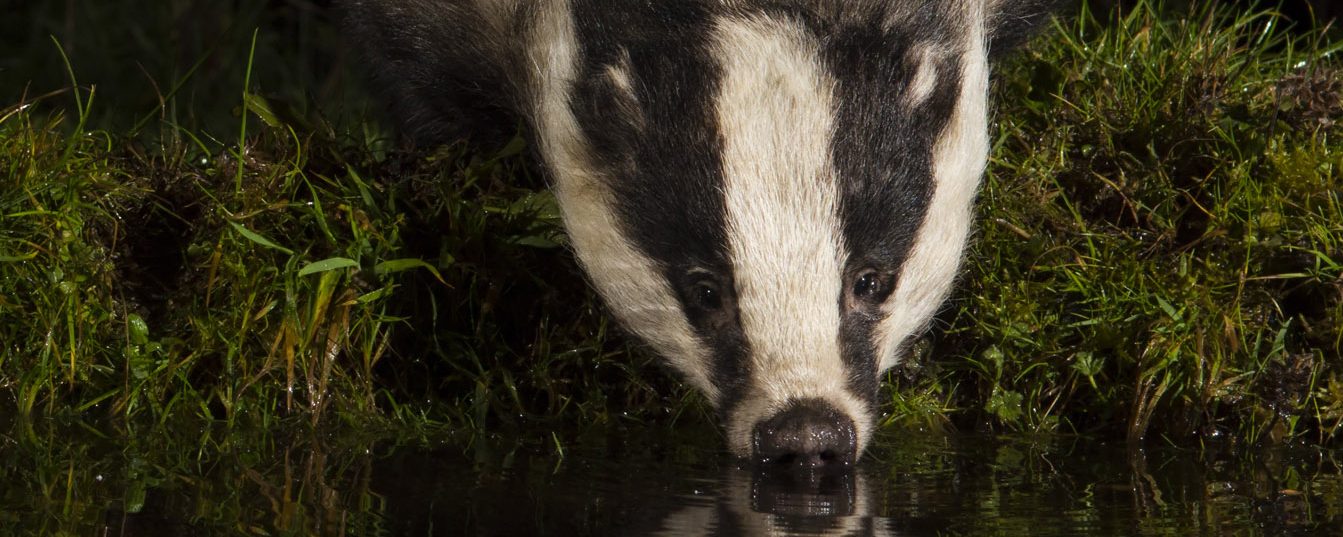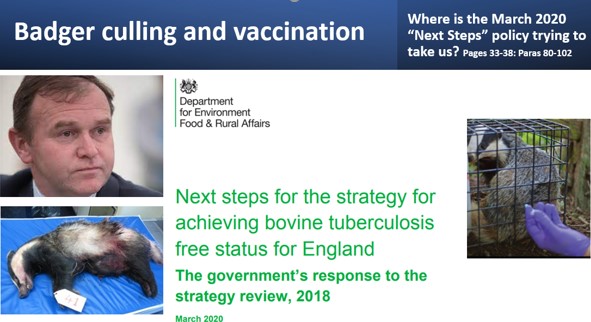 Labour took over Government in July 2024, with a manifesto that announced an end to “ineffective” badger culling. But since then there has been little change in the perpetual failings of Government response to the scientific and policy issues.
Labour took over Government in July 2024, with a manifesto that announced an end to “ineffective” badger culling. But since then there has been little change in the perpetual failings of Government response to the scientific and policy issues.
Culling of largely healthy badger adults and cubs has continued in the High Risk Area of England and beyond; figures for the numbers killed under Labour rule in 2024 will be released in May and are likely to be around 15,000. Shamefully, a new area in Cumbria,in the Low Risk Area was licensed for 100% targeted culling, again with very few active bTB breakdowns, all of which were caused by infected cattle movements. A few hundred badgers will have been needlessly shot there so that Defra, APHA and Natural England can show the NFU that they are keeping the cull plates spinning.
The old Government plans for mass “targeted culling” across the UK which were at the consultation stage during the General Election were rightly scrapped, but they have been replaced by a stated aim to bring forward badger vaccination. Defra and APHA just won’t accept that badgers are not a significant part of the bovine TB problem in England, and move on to cattle based measures that would rapidly bring the disease under control. This is despite published peer-reviewed science that clearly shows how badger culling is based on uncertain science and that it cannot be shown to have reduced bTB in cattle.
 Now a trickle of papers are being published that seem to reveal the policy direction DEFRA is pushing for adoption for England, and hence Wales and Northern Ireland. APHA staff seem to be scrupulously sticking to civil service tribal behaviours, ignoring published science that they do not like, continuing to try to frame “association” as “cause and effect”, and championing confirmation bias. With “Tuberculosis in found dead badgers at the edge of the expanding bovine tuberculosis epidemic”, the text “highlights the co-incidence of infection in badgers and cattle in parts of the southern edge area consistent with localised clustering of infection in both species.” But this is not surprising, and provides no insight into the direction of infection. Yet the farming press immediately put a spin on the work, saying it “provides new insight into the potential role of badgers in the transmission of TB, particularly in areas where the disease has not yet fully taken hold in cattle populations”. They continue “Badgers have long been implicated in the spread of TB to cattle, and this study suggests that they continue to play a role in areas near the edge of the disease’s established range.” Written to keep the badger blame flame alive.
Now a trickle of papers are being published that seem to reveal the policy direction DEFRA is pushing for adoption for England, and hence Wales and Northern Ireland. APHA staff seem to be scrupulously sticking to civil service tribal behaviours, ignoring published science that they do not like, continuing to try to frame “association” as “cause and effect”, and championing confirmation bias. With “Tuberculosis in found dead badgers at the edge of the expanding bovine tuberculosis epidemic”, the text “highlights the co-incidence of infection in badgers and cattle in parts of the southern edge area consistent with localised clustering of infection in both species.” But this is not surprising, and provides no insight into the direction of infection. Yet the farming press immediately put a spin on the work, saying it “provides new insight into the potential role of badgers in the transmission of TB, particularly in areas where the disease has not yet fully taken hold in cattle populations”. They continue “Badgers have long been implicated in the spread of TB to cattle, and this study suggests that they continue to play a role in areas near the edge of the disease’s established range.” Written to keep the badger blame flame alive.
Next we get “Can badger vaccination contribute to bovine TB control? A narrative review of the evidence”. Here we get the following bold statement in the abstract: “Modelling studies evaluating different strategies for controlling TB in badgers predict that badger vaccination will reduce TB prevalence in badger populations and lead to corresponding reductions in cattle herd disease incidence.” There may be some evidence that badger vaccination will reduce bTB prevalence in badgers, but there is no certainty that this will lead to corresponding reductions in cattle herd disease incidence. Yet Government scientists continue to try to groom the science world and the public into believing their partial interpretations of the science, and then fit them to their chosen policies. Policy driven evidence once again.
And a recently posted pre-print “Bovine tuberculosis model validation against a field study of badger vaccination with selective culling” introduces a sinister prospect. If you thought all forms of targeted culling were off the table, think again. Test, and Vaccinate or Remove (TVR) is now being discussed once more. (The TVR approach involves capturing live badgers, testing them for TB with an unreliable test, vaccinating those that test negative to the disease and killing those that test positive). Using data from the Irish ‘Four areas’ culling trials of the 1990’s and data from the Randomised Badger Culling Trials (RBCT), this paper is a claim for the efficacy of modelling in predicting culling outcomes. But the problems of such modelling remain the same; the quality of the data, the size of the samples, the appropriateness of the models used. And the problems of separating the effects of different variables also remain, as we have seen with the clumsy Government interpretation of APHA’s ‘Birch’ paper in 2024, brought out (unsuccessfully) to try to railroad ‘targeted’ culling through. Garbage in, garbage out.
None of the above publications or pre-prints have cited publications that demonstrate that the efficacy of badger culling is not evidenced. Meanwhile, the latest Government initiated review of ‘new’ science since 2018 continues in private, and is due to report by the end of June when it will be given to the hapless BTB Partnership. Commissioned by the government last year, most of the review panel scientist appointees have been closely associated or involved in Government science for many years, and have provided or supported the rationale on which intensive badger culling has been pursued since 2013. They rubber stamped it again at the last review. Can we expect an objective conclusion this time?
Government produced science on badgers and bovine TB within the UK is now completely lacking impartiality; it is unbalanced and mired in confirmation bias. Just read the first line of this Abstract (DAERA funded) in “Landscape as a Shared Space for Badgers and Cattle: Insights Into Indirect Contact and Bovine Tuberculosis Transmission Risk”; this paper is inference without evidence. Papers on badger vaccination and trap-side testing are becoming speculative narratives seeking to justify the past papers that the authors have been writing, sometimes for decades, believing that the ‘ground zero’ analyses and hypotheses were sound. With nowhere to go, they just keep digging. And dangerously claiming that TVR could help reduce bTB in cattle, even if half of the badgers killed are healthy false positives. It is more of the same old guesswork in play.
The direction of travel of this recent trickle of papers by government scientists suggests that the new Godfray review will switch from recommending badger vaccination experiments to TVR experiments, while cranking up ‘hotspot’ culling (which is targeted culling with a different name) to keep the ‘old science’ going. Presumably, as in 2013, there will be a ghastly pilot of the new policy that would provide DEFRA with what they need to keep the NFU and others happy with continued culling. Meanwhile, the public will continue to foot the bill for dirty cattle trading. And yet again Natural England get a stay of execution, safe from the recently announced review of ‘quangos for the chop’ by retaining their badger cull licensing function.
If Government, and Ministers during their short tenures, ever gets serious about making England TB free, they need to look to cattle-based solutions. The long held historic fixation with badgers is not borne out by credible science. They need to address cattle measures head on, rather than continuing to pretend they couldn’t rapidly stop bTB in its tracks if they wanted to, and save all those involved from massive cost, needless destruction and prolonged misery. Why won’t they do that?
If you support challenging the flawed science behind the badger cull and a parliamentary debate on the issue, please sign the petition linked below calling to “End the Badger cull and adopt other approaches to bovine TB control”:



 Last Thursday 23rd September, Hertfordshire and Middlesex Badger Group hosted a webinar to look closely at the governments “Next Steps” strategy for achieving bovine tuberculosis free status for England.
Last Thursday 23rd September, Hertfordshire and Middlesex Badger Group hosted a webinar to look closely at the governments “Next Steps” strategy for achieving bovine tuberculosis free status for England.